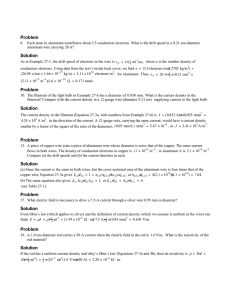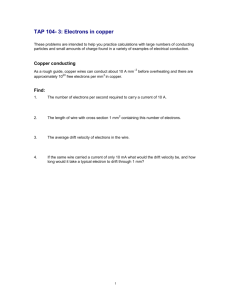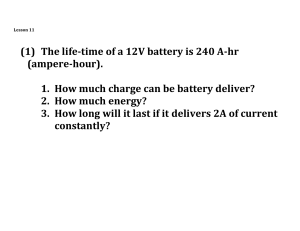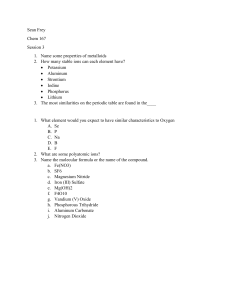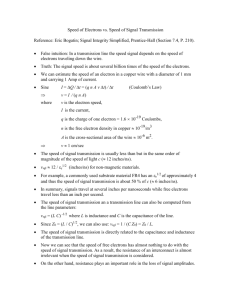CHAPTER 27 ELECTRIC CURRENT Problem Solution
advertisement
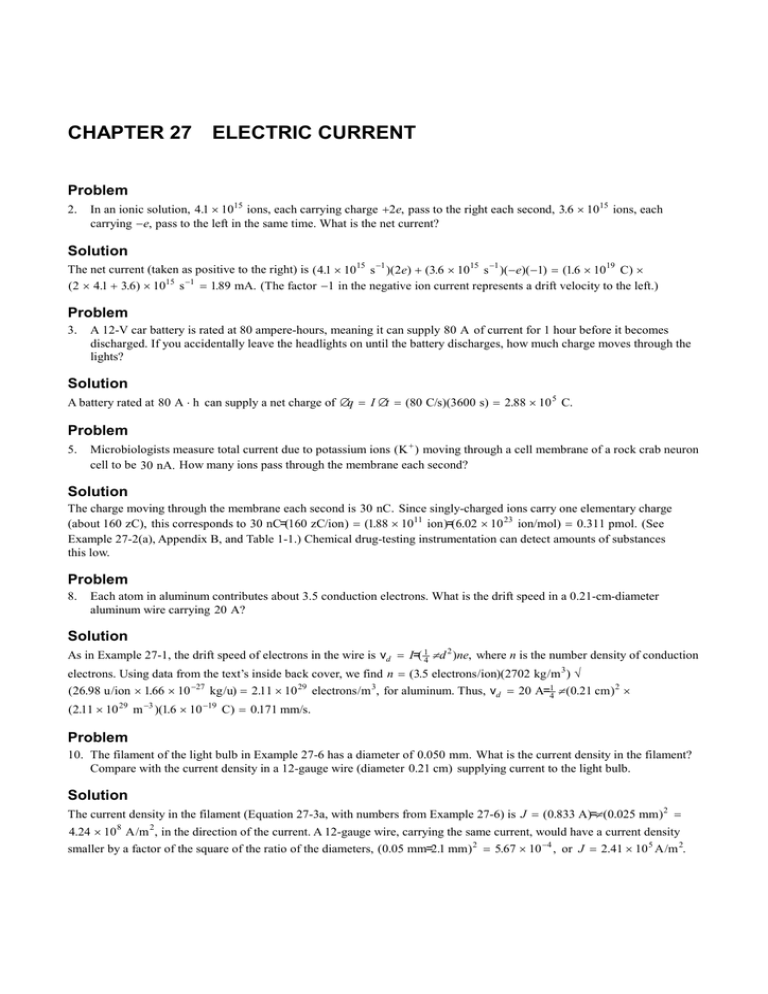
CHAPTER 27 ELECTRIC CURRENT Problem 2. In an ionic solution, 4.1 × 1015 ions, each carrying charge +2e, pass to the right each second, 3.6 × 1015 ions, each carrying −e, pass to the left in the same time. What is the net current? Solution The net current (taken as positive to the right) is ( 4.1 × 1015 s −1 )(2e) + (3.6 × 1015 s −1 )( − e)( −1) = (1.6 × 1019 C) × (2 × 4.1 + 3.6) × 1015 s −1 = 1.89 mA. (The factor −1 in the negative ion current represents a drift velocity to the left.) Problem 3. A 12-V car battery is rated at 80 ampere-hours, meaning it can supply 80 A of current for 1 hour before it becomes discharged. If you accidentally leave the headlights on until the battery discharges, how much charge moves through the lights? Solution A battery rated at 80 A ⋅ h can supply a net charge of ∆q = I ∆t = (80 C/s)(3600 s) = 2.88 × 10 5 C. Problem 5. Microbiologists measure total current due to potassium ions ( K + ) moving through a cell membrane of a rock crab neuron cell to be 30 nA. How many ions pass through the membrane each second? Solution The charge moving through the membrane each second is 30 nC. Since singly-charged ions carry one elementary charge (about 160 zC), this corresponds to 30 nC=(160 zC/ion ) = (1.88 × 1011 ion )=(6.02 × 10 23 ion/mol) = 0.311 pmol. (See Example 27-2(a), Appendix B, and Table 1-1.) Chemical drug-testing instrumentation can detect amounts of substances this low. Problem 8. Each atom in aluminum contributes about 3.5 conduction electrons. What is the drift speed in a 0.21-cm-diameter aluminum wire carrying 20 A? Solution As in Example 27-1, the drift speed of electrons in the wire is vd = I=( 14 π d 2 )ne, where n is the number density of conduction electrons. Using data from the text’s inside back cover, we find n = (3.5 electrons/ion)(2702 kg/m 3 ) ÷ (26.98 u/ion × 1.66 × 10 −27 kg/u) = 2.11 × 10 29 electrons/m 3, for aluminum. Thus, vd = 20 A=14 π (0.21 cm ) 2 × (2.11 × 10 29 m −3 )(1.6 × 10 −19 C) = 0.171 mm/s. Problem 10. The filament of the light bulb in Example 27-6 has a diameter of 0.050 mm. What is the current density in the filament? Compare with the current density in a 12-gauge wire (diameter 0.21 cm) supplying current to the light bulb. Solution The current density in the filament (Equation 27-3a, with numbers from Example 27-6) is J = (0.833 A)=π (0.025 mm ) 2 = 4.24 × 10 8 A/m 2 , in the direction of the current. A 12-gauge wire, carrying the same current, would have a current density smaller by a factor of the square of the ratio of the diameters, (0.05 mm=2.1 mm ) 2 = 5.67 × 10 −4 , or J = 2.41 × 10 5 A/m 2. CHAPTER 27 643 Problem 13. A plasma used in fusion research contains 5.0 × 1018 electrons and an equal number of protons per cubic meter. Under the influence of an electric field the electrons drift in one direction at 40 m/s, while the protons drift in the opposite direction at 6.5 m/s. (a) What is the current density? (b) What fraction of the current is carried by the electrons? Solution The proton current density is J p = nevd , p = (5.0 × 1018 m −3 )(1.6 × 10 −19 C)(6.5 m/s) = 5.20 A/m 2 (positive in the direction of vd , p ), and the electron current density is J e = n( − e)vd , e = (5.0 × 1018 m −3 )( −1.6 × 10 −19 C)( −40 m/s) = 32.0 A/m 2 . (a) The total current density is J p + J e = 37.2 A/m 2, and (b) the fraction carried by electrons is 32.0=37.2 = 86.0%. Problem 14. In Fig. 27-22, a 100-mA current flows through a copper wire 0.10 mm in diameter, a 1.0-cm-diameter glass tube containing a salt solution, and a vacuum tube where the current is carried by an electron beam 1.0 mm in diameter. The . × 10 29 m −3. The current in the solution is carried equally by positive and density of conduction electrons in copper is 11 negative ions with charges ±2e; the density of each ion species is 6.1 × 10 23 m −3. The electron density in the beam is 2.2 × 1016 m −3. Find the drift speed in each region. 1.0 cm 0.10 mm Wire Solution 1.0 mm Wire Electron beam FIGURE 27-22 Problem 14. Solution In the copper wire, vd = I=neA = (10 −1 A)(11 . × 10 29 m −3 ) −1 (1.6 × 10 −19 C) −1 ( 14 π × 10 −8 m 2 ) −1 = 0.723 mm/s. In the solution, the positive and negative ions have equal charge magnitudes, number, and current densities, by hypothesis, so J = n+ (2 e)vd + n− ( −2e)( − vd ) = 4nevd . Thus, vd = J=4ne = (10 −1 A)=4( 14 π × 10 −4 m 2 )(1.6 × 10 −19 C)(6.1 × 10 23 m −3 ) = 3.26 mm/s. (Since the current density is uniform, J = I=A. ) In the vacuum tube, vd = (10 −1 A )( 14 π × 10 −6 m 2 ) −1 × (1.6 × 10 −19 C) −1 (2.2 × 1016 m −3 ) −1 = 3.62 × 10 7 m/s. Problem 15. In a study of proteins mediating cell membrane transport, microbiologists measure current versus time through the cell membranes of oocytes (nearly mature egg cells) taken from the African clawed frog, Xenopus. The measured current versus time is given approximately by I = 60t + 200t 2 + 4.0t 3, with t in seconds and I in nA. Find the total charge that flows through the cell membrane in the interval from t = 0 to t = 5.0 s. Solution (a) If we use Equation 27-1b for the charge, then q = (30 + 1 3 × 1000 + 25)(25 nC) = 9.71 µ C. z 5s 0 I dt = (60 nA/s) 12 t 2 + (200 nA/s 2 ) 13 t 3 + ( 4 nA/s 3 ) 14 t 4 5s 0 = Problem 18. A cylindrical tube of sea water carries a total electric current of 350 mA. If the electric field in the water is 21 V/m, what is the diameter of the tube? 644 CHAPTER 27 Solution Assuming a uniform current density obeying Ohm’s Law, we find J = E=ρ = I=14 π d 2 , or d = 2[(0.22 Ω ⋅ m )(350 mA)=π(21 V/m )] 1=2 4 ρI=π E = = 6.83 cm (see Table 27-1). Problem 20. There is a potential difference of 2.5 V between opposite ends of a 6.0-m-long iron wire. (a) Assuming a uniform electric field in the wire, what is the current density? (b) If the wire diameter is 1.0 mm, what is the total current? Solution (a) Equation 27-4b (Ohm’s law in point form) applies to iron, under the circumstances stated. Thus, J = E=ρ = (V=ℓ)=ρ = (2.5 V)=(6 m)(9.71 × 10 −8 Ω ⋅ m) = 4.29 × 10 6 A/m 2 . (b) I = J ( 14 πd 2 ) = ( 4.29 × 10 6 A/m 2 ) d 1 4 i π × 10 −6 m 2 = 3.37 A. Problem 24. A pure silicon crystal contains 4.9 × 10 28 atoms/m 3. At room temperature, the density of electron-hole pairs is 1 × 1016 m −3. In what concentration (aluminum atoms per silicon atom) must aluminum be added to give a conductivity 1000 times that of pure silicon? Assume that each aluminum atom contributes one extra hole, and that the conductivity is proportional to the density of charge carriers. Solution Since an electron-hole pair represents two charge carriers, while an aluminum impurity atom contributes only one carrier, we desire the density of impurity atoms to satisfy the relation 10 3 = σ impurity =σ intrinsic = nAl =2 npairs , or nAl = 10 3 × 2 × 1016 m −3 = 2 × 1019 m −3. (Pure and doped crystals are called intrinsic and impurity semiconductors, respectively.) This implies an aluminum concentration of only nAl =n Si = 2 × 1019 m −3=4.9 × 10 28 m −3 = 4.08 × 10 −10. Problem 27. What is the resistance of a heating coil that draws 4.8 A when the voltage across it is 120 V? Solution The macroscopic form the Ohm’s Law is probably applicable to the heating coil, which is typically a coil of wire. Equation 27-6 gives R = V=I = 120 V=4.8 A = 25 Ω. Problem 29. What is the current in a 47-kΩ resistor with 110 V across it? Solution Provided the resistor obeys Ohm’s law, I = V=R = 110 V=47 kΩ = 2.34 mA. Problem 30. The “third rail” that carries the electric power to a subway train is a rectangular iron bar whose cross section measures 10 cm × 15 cm, as shown in Fig. 27-23. What is the resistance of a 5.0-km piece of this rail? Solution If the third rail behaves like a uniform ohmic material, its resistance is given by Equation 27-7 (with resistivity from Table 27-1), R = ρℓ=A = (9.71 × 10 −8 Ω ⋅ m)(5 km )=(10 × 15 cm 2 ) = 32.4 mΩ. CHAPTER 27 645 Problem 33. The presence of a few ions makes air a conductor, albeit a poor one. If the total resistance between the ionosphere and Earth is 200 Ω, how much current flows as a result of a 300-kV potential difference between Earth and ionosphere? Solution If the total atmospheric resistance is 200 Ω at 300 kV, Equation 27-6 gives a current of I = V=R = 300 kV=200 Ω = 1.5 kA. Problem 36. You have a cylindrical piece of material 2.4 cm long and 2.0 mm in diameter. When you attach a 9-V battery to the ends of the piece, a current of 2.6 mA results. Which material from Table 27-1 do you have? Solution For a uniform piece of material, Equations 27-6 and 7 imply ρ = RA=ℓ = VA=Iℓ = V ( 14 π d 2 )=Iℓ = (9 V )( 14 π )(2 mm ) 2 ÷ (2.6 mA)(2.4 cm) = 0.453 Ω ⋅ m. This is closest to the resistivity of germanium in Table 27-1. Problem 39. Engineers call for a power line with a resistance per unit length of 50 mΩ/km. What wire diameter is required if the line is made of (a) copper or (b) aluminum? (c) If the costs of copper and aluminum wire are $1.53/kg and $1.34/kg, which material is more economical? The densities of copper and aluminum are 8.9 g/cm 3 and 2.7 g/cm 3, respectively. Solution From Equation 27-7, R=ℓ = ρ=( 14 πd 2 ), so d = 2 ρ=π ( R=ℓ). With resistivities from Table 27-1, (a) dCu = 2 (1.68 × 10 −8 Ω ⋅ m)=(50π mℓ/km) = 2.07 cm, and (b) d Al = diameters, the cost of one meter of wire is 1 4 2 π dCu (1 2.65=1.68 dCu = 2.60 cm (see Problem 37). (c) With these m )(8.9 g/cm )($1.53/kg) = $4.58 for copper, and $1.92 for aluminum. 3 Problem 43. A car’s starter motor draws 125 A with 11 V across its terminals. What is its power consumption? Solution Equation 27-8 gives the power supplied to the motor, P = VI = (11 V )(125 A ) = 1.38 kW. Problem 45. A watch uses energy at the rate of 240 µW. How much current does it draw from its 1.5-V battery? Solution Rearranging Equation 27-8, we find I = P=V = 240 µW=1.5 V = 160 µA. Problem 48. Use the numbers from Problem 33 to find the electric power dissipation in Earth’s atmosphere. If we could harness this power, would it make a dent in humanity’s 1012-W electric power consumption? Solution From Equation 27-9b and Problem 33, P = V 2=R = (300 kV ) 2=(200 Ω) = 450 MW, or about 0.045% of the world’s electric power consumption. 646 CHAPTER 27 Problem 50. The “instant on” feature of all the television sets in the United States requires the continuous power output of a typical large power plant—about 1000 MW. If there are 10 8 TVs in the United States, how much current does the “instant on” circuit of each draw from the 120-V power line? Solution Each TV-set uses 10 9 W=10 8 sets = 10 W of power. Therefore, I = P=V = 10 W=120 V = 83.3 mA. (This is an average current for TV-sets treated as ac-resistors.) Problem 54. Your author’s house uses approximately 110 kWh of electrical energy each week. If that energy is supplied at 240 V, what average resistance does the house present to the power line? Solution The given weekly average energy translates into an average power consumption of 110 kW ⋅ h/wk = 110 kW ⋅ h ÷ (7 × 24 h) = 655 W. Therefore, the average resistance is R = V 2=P = (240 V) 2=655 W = 88.0 Ω . Problem 65. A metal bar has a rectangular cross section 5.0 cm by 10 cm, as shown in Fig. 27-25. The bar has a nonuniform conductivity, ranging from zero at the bottom to a maximum at the top. As a result, the current density increases linearly from zero at the bottom to 0.10 A/cm 2 at the top. What is the total current in the bar? Solution The current density is J = (0.1 A/cm 2 )( x=10 cm)kɵ , in the coordinate system superposed on Fig. 27-25. The cross section can be divided into strips of area dA = (5 cm) dx kɵ (over which J is constant), so the total current in the bar (Equation 27-3a in differential form) is: I = z x -sect J ⋅ dA = = (0.05 A/cm 2 ) z 10 cm (10 −2 A/cm 3 )(5 cm ) x dx 0 1 (10 cm ) 2 = 2.5 A. 2 J 5 0.10A/cm2 dx y FIGURE z dA J50 27-25 Problem 65 Solution. Problem 70. A parallel-plate capacitor has plates of 10 cm 2 area separated by a 1.0-mm layer of glass insulation with resistivity ρ = 1.2 × 1013 Ω ⋅ m and dielectric constant κ = 5.6. The capacitor is charged to 100 V and the charging battery disconnected. (a) What is the initial rate of discharge (i.e., the current through the insulation)? (b) At this rate, how long CHAPTER 27 647 would it take the capacitor to discharge fully? (The rate does not remain constant; more on this in the next chapter.) Solution The electric field in the glass between the plates is approximately uniform, E = V=d , so the leakage current density, J = E=ρ, is too. Therefore, the initial current is I 0 = J 0 A = ( E0 =ρ ) A = V0 A=ρd = (100 V)(10 −3 m 2 )(1.2 × 1013 Ω ⋅ m) −1 × (10 −3 m ) −1 = 8.33 × 10 −12 A. (Alternatively, R = ρd=A and I 0 = V0 =R.) (b) If the initial charge, q0 = CV0 = (κ ε 0 A=d )V0 , were depleted at a constant rate, I 0 = dq=dt, it would take time τ = q0 =I 0 = (κ ε 0 AV0 =d )=(V0 A=ρd ) = κ ε 0 ρ = (5.6)(8.85 × 10 −12 F/m )(1.2 × 1013 Ω ⋅ m ) = 595 s = 9.91 min to completely discharge. (Note: τ is known as the relaxation time of the material, glass in this case; in Section 28-6, τ = ( ρd=A)(κ ε 0 A=d ) = RC is called the time constant.) Problem 71. Figure 27-27 shows a resistor made from a truncated cone of material with uniform resistivity ρ. Consider the cone to be made of thin slices of thickness dx, like the one shown; Equation 27-7 shows that the resistance of each slab is dR = ρ dx=A. By integrating over all such slices, shows that the resistance between the two flat faces is R = ρℓ=π ab. (This method assumes the equipotentials are planes, which is only approximately true.) FIGURE 27-27 Solution z Problem 71 Solution. dR, where dR = ρ dx=A is the resistance of a thin disk as shown on Fig. 27-27. The area of such a disk is A = π y , where y = a + (b − a) x=ℓ is the radius and 0 ≤ x ≤ ℓ as shown. Then As suggested, consider that the total resistance R equals cone 2 R= z ℓ 0 ρ dx π [a + (b − a) x=ℓ] 2 = ρ π − 1 F ℓ I H b − a K [a + (b − a) x=ℓ] ℓ = 0 F H ρ ℓ π b−a I F 1 − 1 I = ρℓ . K H a b K π ab (This result depends on the condition that the flat faces and parallel circular cross-sections of the cone are equipotential surfaces.) bles 19-1 and 27-1.
